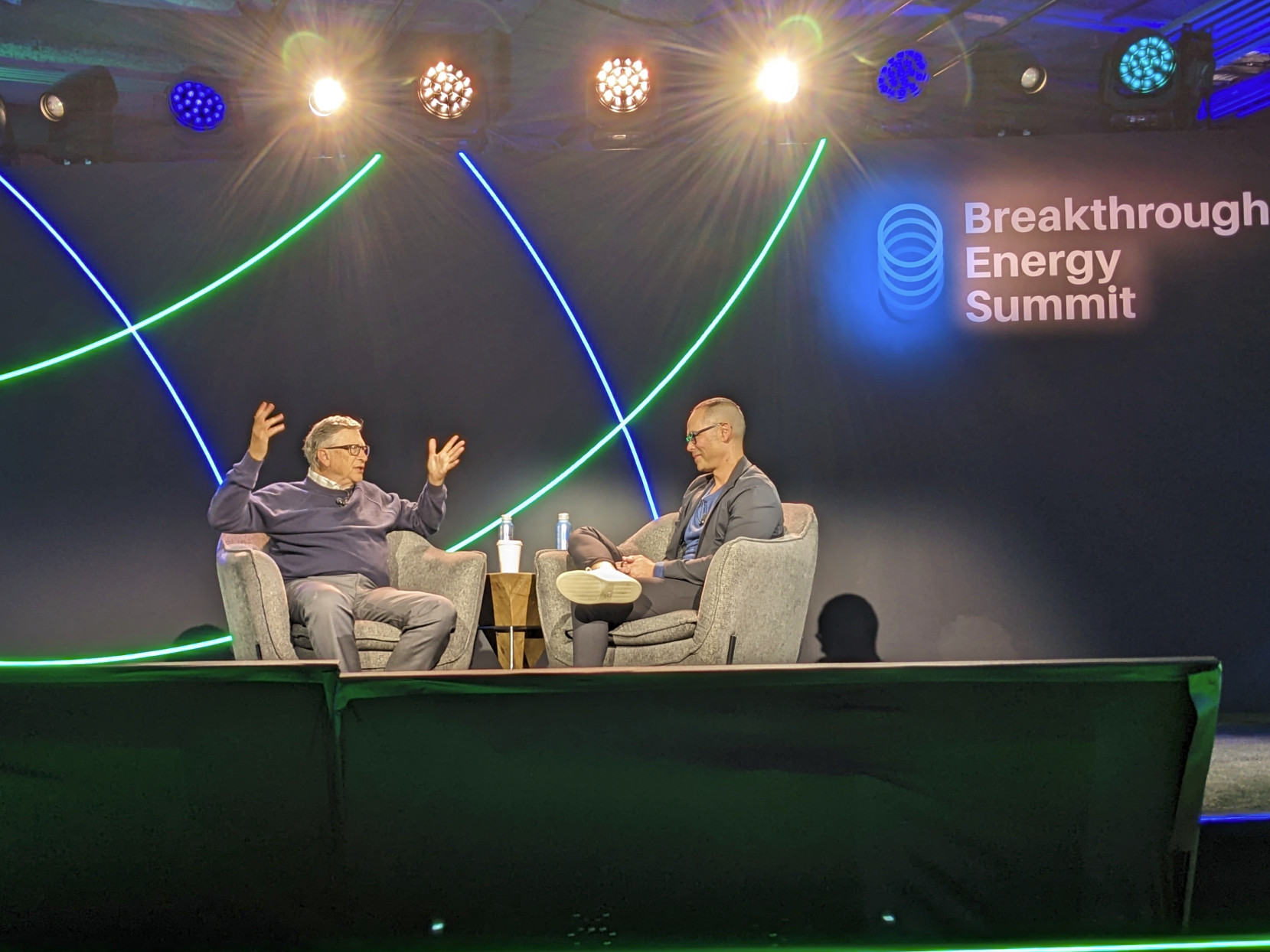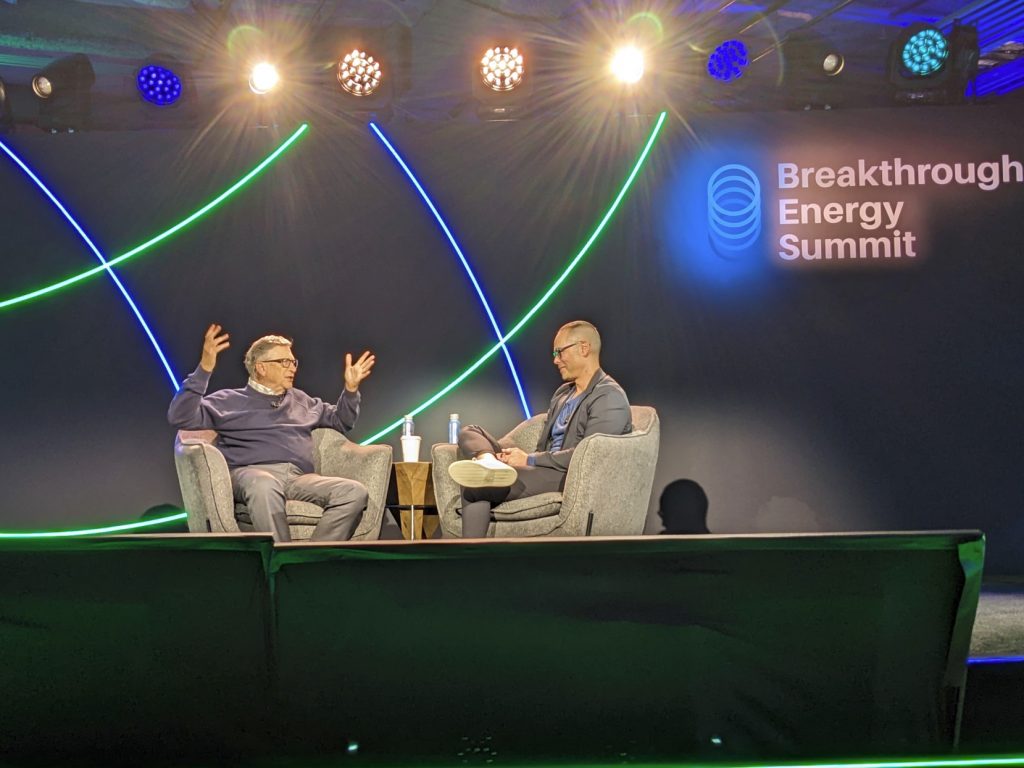
Breakthrough Energy, the Bill Gates-led effort to stoke innovation in climate technology, is holding its inaugural summit this week in Seattle. It kicked off its program on Tuesday with a conversation with Gates and Rodi Guidero, executive director of Breakthrough Energy.
The two took stock of the challenges and progress in addressing climate change since Gates launched the Breakthrough Energy initiative seven years ago at the U.N. Climate Change Conference in Paris.
“I’m quite amazed at how far we’ve come since 2015,” Gates told the crowd of company executives, policymakers, investors and journalists.
“In 2015, the private sector was not there,” he said. “And the understanding of the problem …. people were like okay, let’s plant a few trees.”
Now the private sector, including carbon emitters as well as companies working to develop and deploy new technologies to slow the warming, is “incredibly serious,” Gates said.
The three-day event features discussions with climate leaders including Gates, U.S. Special Presidential Envoy for Climate John Kerry, U.S. Energy Secretary Jennifer Granholm, BlackRock CEO Larry Fink, and Microsoft President Brad Smith. The summit was held at the Bell Harbor International Conference Center on the Seattle waterfront.
The backdrop to the event was a smokey Pacific Northwest still in the grips of a record-setting stretch of rain-less days that on Sunday hit 88 degrees, smashing the past record. The conditions, the state’s climatologist recently told GeekWire, are a “dress rehearsal” for the region as the world keeps warming.
Breakthrough Energy is trying to take a holistic approach to addressing climate change, supporting early stage companies and researchers, businesses ready to deploy their technologies, and public policy in the sphere. Different aspects of the effort are funded by private capital and philanthropic donations. Its original focus was its venture capital arm, Breakthrough Energy Ventures, which has invested in 105 companies so far.
“The diversity of the good ideas is way beyond what I expected,” Gates said of innovation in the sector.
But climate tech is harder and slower than what is possible to create in software, said Gates, which is where he made his fortune as co-founder of Microsoft.
“In software everything’s so easy,” he said. “We don’t have to build physical things. We don’t have to scale physical things.”
The physical innovations in climate tech don’t follow Moore’s Law, Gates said, which predicts a doubling of computing power every couple of years. That said, Gates added, “the great [climate] ideas are enough if they scale up.”
Another hurdle is just the tracking and perception of progress.
“If you keep the primary measures, which is the emissions reductions in the near term, you’re going to be very depressed,” Gates said. Because while countries and even companies are setting lofty ambitions for curbing carbon releases, for many that progress has been modest — if it’s even going in the right direction at all.
Gates argued instead for tracking the “green premiums,” a term he promoted in his 2021 climate book, which are the price differences between fossil-fuel burning technologies and climate friendly alternatives. As the green premiums shrink, governments, companies and individuals can afford to choose planet friendly alternatives. Already that is happening with wind and solar power and electric vehicles.
But big swaths of the economy, particularly the industrial sector and its appetite for steel and cement, remain difficult areas for shrinking the cost differences. Progress is slower in this field, but Gates doesn’t argue for taking on the easier sectors first because there might be quicker returns.
“If anything, you should work on the hard ones first and put more capital into those because you have this deadline of 2050,” Gates said, referring to the goal for reducing carbon emissions to zero by mid-century.
Also on Tuesday, Gates released an article that’s sort of a climate-focused version of the letter that Gates, as co-chair of the Bill & Melinda Gates Foundation, shares annually regarding global health initiatives. In the article he says that in the past 15 years “an influx of private and public investment has accelerated innovation faster than I dared hope. This progress makes me optimistic about the future.”
He balanced this outlook with the acknowledgement that the problem is huge, noting that, “We have to replace every single piece of infrastructure dedicated to doing things the old way with infrastructure dedicated to doing things in a new way — and that doesn’t happen instantly, especially considering the mind-boggling scale of the job.”
At the summit, Gates ended his session with an almost incongruently upbeat message for an audience committed to tackling the daunting challenge of climate change.
“Thanks for believing in this cause,” he said. “We’ll have a lot of fun solving this problem.”

